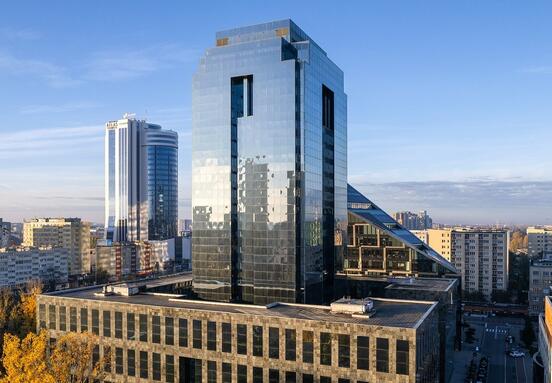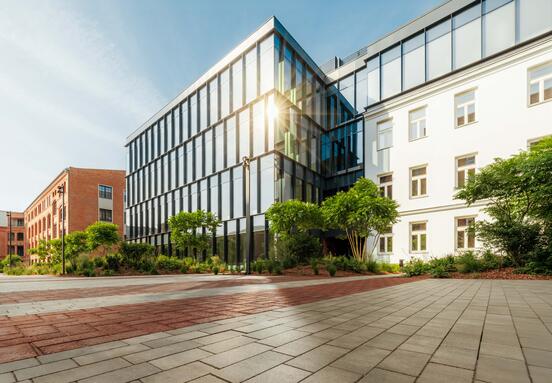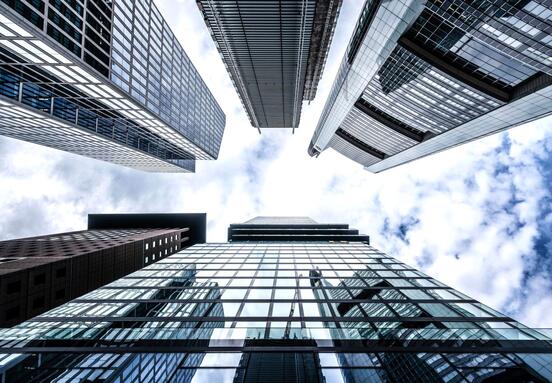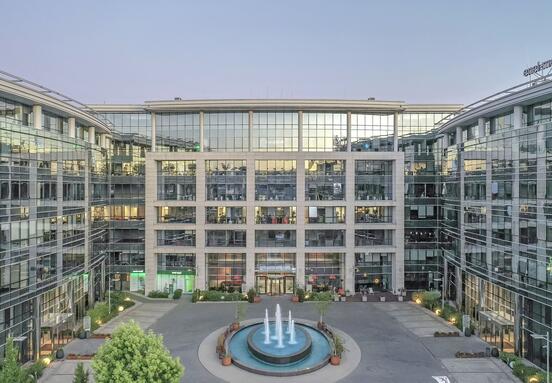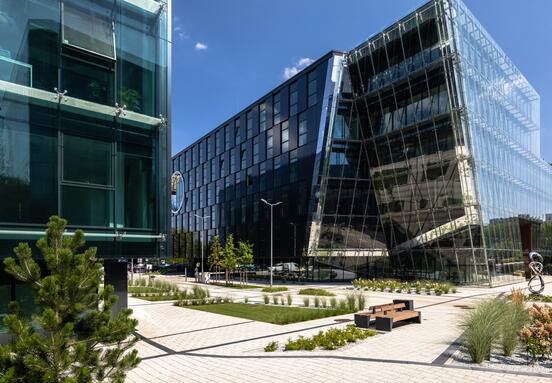New complexes are now designed mainly for users' convenience. Tenants' comfort is a primary indicator in the process of preparing commercial investments. – Today, market belongs to projects offering various functions, with well-designed common areas, using not only the latest technological solutions, but also the potential of public space - informs Bartłomiej Zagrodnik, Managing Partner at Walter Herz.
Among the new ventures, there are many large, compound investments with an area around the buildings managed in such a way that the facility is as attractive as possible for employees and local residents.
- Office building is not only a place of work, but also a place to relax and spend free time in. The multifunctional nature of the emerging facilities is undoubtedly much more attractive to tenants than just office projects. The more functions and practical amenities located in and around the property, the more interesting location for companies looking for offices - explains Bartłomiej Zagrodnik.
Warsaw Spire was first
Ghelamco company is a precursor of implementation of sustainable development principles in their projects. The company’s main investment Warsaw Spire has become one of the most well-known facilities in Warsaw. The focal point of the project located near the Daszyńskiego Roundabout is Plac Europejski square, a high-quality open outdoor public space with restaurants, cafes and an art gallery.
The demand for mixed-use complexes and their competitive advantage on the market can be demonstrated by the success of the capital Koneser and Browary Warszawskie facilities. But also the decline in interest in the mono-office Służewiec Przemysłowy district, which is now heading towards expanding the range of services and functions, to bring tenants back to their office offer. A similar trend can also be observed on the residential market, where real estate offering co-living solutions, including multifunctional common space, rank the highest among tenants.
Office buildings and a brewery
Echo Investment specializes in developing vast areas located in city centers and creating integrated urban fabric. The company is currently implementing a multifunctional Browary Warszawskie facility. The offices will constitute about 50 per cent of space created in the investment. The complex is to include four office buildings, five residential buildings, over 8 thousand sq m. of space intended for services, retail and gastronomy, as well as public space with urban squares, intimate streets and greenery. Whereas, Biura przy Bramie office building which was leased and completed at the end of last year, has already been sold by the developer.
Nowadays, the implementation of more office buildings in the quarter of Grzybowska, Krochmalna, Wronia and Chłodna streets is under way. Biura przy Willi and Biura przy Warzelni complexes will be located in the immediate vicinity of the historic Warzelnia brewhouse, which will become a restaurant and a brewery. The architecture of Biura przy Warzelni facility allows for a direct passageway to the 19th century Piwnice Czasu, which will become an intimate gastronomic complex with about a dozen restaurants, cafes and pubs. The place will also provide Ogród Centralny garden, and one of the crossings will connect Rynek Warzelni Square with Plac Dolny Square.
A place to work and live
The investor is also preparing the construction of the multifunctional Towarowa 22 investment in Warsaw. Whereas in Łódź, the company is planning to develop an almost 8-hectare area of the former Karol Scheibler factory, with 90 thousand sq m. of residential, office and retail space, as well as gastronomic, commercial and cultural facilities. 20 buildings will be erected in Łódź’s investment at Tymienieckiego Street, and a historic power plant will be located in its heart. The complex will offer apartments, offices, shops, gastronomic establishments and cultural facilities. It will also include squares, common spaces and green areas, a total of 40 thousand sq m. There will also be parking spaces for car sharing, bicycle paths and bike service stations. The facility will become a place of work and life for about 6 thousand people.
Towarowa 22 is also a city-forming investment. The developer emphasizes that it will be a commercial project focused on people, because in the office surroundings people need a place to spend time together. 230 thousand sq m. of modern space will be built in the area of 6.5 ha, in the center of Warsaw. In the central part of the complex will include Plac Kazimierza Wielkiego square with the renovated pavilion of Dom Słowa Polskiego and the reconstructed Wronia Street covered with a glass roof. 25 per cent of buildings in the investment will be designated for retail and the same amount of office space, as well as a hotel, flats, a theater, a festival cinema and a two-hectare green square. Retail concept, with 70 thousand sq m of space, will be created in a completely new manner than a traditional mall. Its central element will constitute a shopping street filled with boutiques, restaurants and services.
Offices, services, retail, entertainment and culture
Sustainable development is also a part of the investment based on the revitalization of the buildings of the former Norblin factory, the implementation which started last year. The project, which the Capital Park Group is implementing on over 2 hectares of land between Prosta, Łucka and Żelazna streets, will bring Warsaw over 64 thousand sq m. of modern space, including 39 thousand sq m. of office space, arranged in a post-industrial, loft character and 24 thousand sq m. dedicated to the entertainment and service, commercial and cultural functions. This place will be an open mini-district with about a dozen buildings located among the inner streets.
Elektrownia Powiśle project was also arranged in accordance with the trend related to spending time in the spirit of slow life. The investment will be delivered soon. Three office buildings, offering nearly 22 thousand sq m. are almost completely leased. The investment located in Warsaw's Powiśle also includes luxurious apartments for rent and a boutique hotel. The offer will be complemented by exclusive boutiques and a food court that will combine open space and traditional restaurants. It will include several dozen different culinary concepts. Beauty Hall with 1500 sq m. of space will combine comprehensive beauty and wellness services.
Varso Place investment located near the Warsaw Central Railway Station will provide a variety of functions. The HB Reavis’ project will include Varso Tower office building, as well as Varso 1 and Varso 2, with, among others, the first NYX design hotel in Poland, belonging to the Leonardo Hotels chain. The investment will bring a total of 144 thousand sq m. of space for lease. In addition to the modern office space, there will also be a public passageway with shops, restaurants, cafes and commercial premises. The 53-storey high tower will bring a unique attraction to the city in just two years. It will house a panoramic restaurant and a bar as well as a terrace open to the public, located at 230 meters.
Panoramic terraces and Spanish stairs
Olivia Star, the tallest building in Northern Poland, which is a part of Olivia Business Center complex will soon offer space that will integrate both residents, tourists, business people and lovers of prestigious events. The building will provide a terrace at an altitude of 150 meters, with a view of the Gulf of Gdańsk, Gdynia, Gdańsk and Sopot and the Tri-City Landscape Park. In addition to the overlook, the new space will provide an attractive culinary offer. A restaurant, which is to open on the 33rd floor, will be run by one of the most successful chefs in the world. Moreover, a conference center space will be arranged on the top floors. The project also includes an intimate exhibition space, where various types of meetings are to take place.
Large "Spanish stairs", designed in the Roman style, located in the lobby of the Warsaw Skyliner office building by Karimpol company, will provide a place for meetings. The glass entrance hall of a 195-meter-tall high rise building at the Daszyńskiego roundabout will be surrounded by a colonnade of 16-meter high poles. The impressive stairs that will be located in it will connect the interior of the hall with an external public passage. The lobby, depending on the needs, will become a place of a spectacular fashion show, an auditorium for a theatrical event, a cinema show, or an art gallery. The design of this investment also provides a whole range of public services. At 30 levels, the building will house offices, and 4 storeys will be used for retail and service purposes. Over 3 thousand sq m. of space will include shops, restaurants, cafes, and fitness. The tower will also offer a two-level Skybar with a panoramic view of the city, located at 165 meters.
Smartphones and artificial intelligence
Nowadays, the office buildings themselves are also interactive. They offer useful facilities, and common areas and co-working areas located in them facilitate the establishment of relationships and exchange of ideas, which favors the development of business. The use of conference rooms, a car park, a reception lobby to register guests or office equipment is already possible using applications supported by smartphones.
Functionality of the buildings is constantly being improved thanks to the latest technologies. Recently, Microsoft and Skanska office company have signed an agreement on strategic PropTech cooperation. It includes an exchange of knowledge and the use of solutions in the field of advanced data analytics, AI mechanisms and cloud computing to create breakthrough innovations for the office real estate industry. As a result, it will allow to obtain in-depth conclusions on the use of the buildings. Data collected from hundreds of sensors and building systems will allow to analyze many parameters, including the way of using common parts and workspace, to understand the needs of tenants and the most effective use of space. Subsequently, it will be possible to adapt the space to the users' requirements, for example through its rearrangement or change of utility functions. Which ultimately leads to the fact that intelligent buildings will create and adapt their spaces to the tenants’ preferences.
Source: Walter Herz

